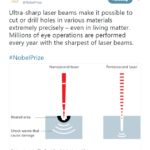The Royal Swedish Academy of Sciences announced that the 2018 Nobel Prize in Physics is being awarded “for groundbreaking inventions in the field of laser physics”, with one half to Arthur Ashkin (US) and the other half jointly to Gérard Mourou (France) and Donna Strickland (U.Waterloo, Canada). Dr. Ashkin is recognized for his development of “optical tweezers” which have allowed tiny organisms to be handled with light beams. Drs. Mourou and Strickland share their prize for “their method of generating high-intensity, ultra-short optical pulses”.
 Canadian physicist Prof. Strickland is being recognized for her research on laser beam amplification and compression undertaken while a PhD student working with Prof. Mourou. Her work on developing the very short, very intense laser pulses, referred to as the Chirped Pulse Amplification (CPA) technique, has transformed the world of laser physics, and opened this field of research to many others around the world. It has led to improvements in eye surgery and machining applications, among other things.
Canadian physicist Prof. Strickland is being recognized for her research on laser beam amplification and compression undertaken while a PhD student working with Prof. Mourou. Her work on developing the very short, very intense laser pulses, referred to as the Chirped Pulse Amplification (CPA) technique, has transformed the world of laser physics, and opened this field of research to many others around the world. It has led to improvements in eye surgery and machining applications, among other things.
In honour of Canada’s own Donna Strickland winning the Nobel prize for physics, this year’s theme for the IDL-Canada celebration will be “high-intensity, ultra-short optical pulses”. We invite Canadian physicists and optical scientists to highlight the results and applications of Chirped Pulse Amplification that resulted in this honour.
